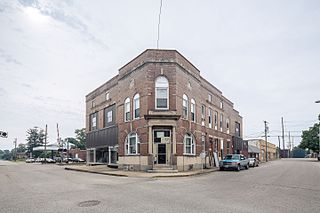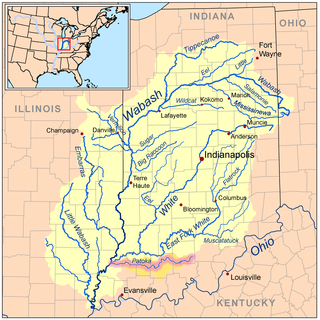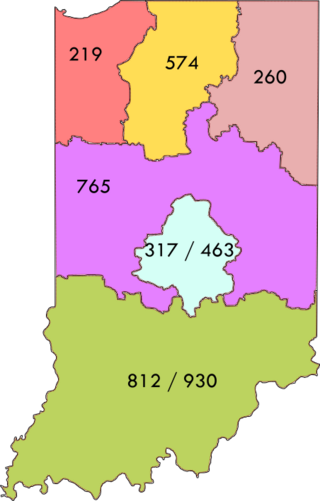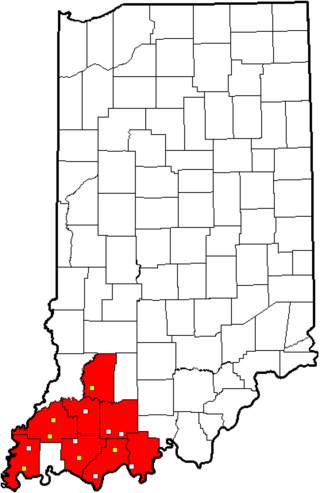
Warrick County is a county located in the U.S. state of Indiana. As of 2020, the population was 63,898. The county seat is Boonville. It was organized in 1813 and was named for Captain Jacob Warrick, an Indiana militia company commander killed in the Battle of Tippecanoe in 1811. It is one of the ten fastest-growing counties in Indiana.

Posey County is the southernmost, southwesternmost, and westernmost county in the U.S. state of Indiana. Its southern border is formed by the Ohio River, and its western border by the Wabash River, a tributary to the Ohio. As of 2020, the population was 25,222. The county seat is Mount Vernon.

Mount Carmel is a city in and the county seat of Wabash County, Illinois, United States. At the time of the 2010 census, the population was 7,284, and it is the largest city in the county. The next largest town in Wabash County is Allendale, population 475.

Fort Branch is the largest town and 2nd largest community in Gibson County, Indiana after Princeton. The population was 2,965 at the 2020 census. It is part of the Evansville, Indiana, Metropolitan Area.

Owensville is the third largest town and the smallest of the five larger communities in Gibson County, Indiana, United States. The population was 1,338 in 2020.

Princeton is the largest city in and the county seat of Patoka Township, Gibson County, Indiana, United States. The population was 8,301 at the 2020 United States Census, and it is part of the greater Evansville, Indiana, Metropolitan Area.

Southern Indiana is a geographic and cultural region that generally comprises the southern third of the U.S. state of Indiana and borders the states of Illinois to the west, Kentucky to the south, and Ohio to the east. Spanning the state's southernmost 33 counties, its main population centers include Southwestern Indiana, the Louisville metropolitan area (south), and the Cincinnati metropolitan area (southeast). The region's history and geography have led to a blending of Northern and Southern cultures, distinct from the rest of the state. It is often considered to be part of the Upland South and lower Midwest.

The Patoka River is a 167-mile-long (269 km) tributary of the Wabash River in southwestern Indiana in the United States. It drains a largely rural area of forested bottomland and agricultural lands among the hills north of Evansville.

Area codes 812 and 930 are telephone area codes in the North American Numbering Plan (NANP) for the southern third of the state of Indiana.

The Wabash Valley is a region located in sections of both Illinois and Indiana. It is named for the Wabash River and, as the name is typically used, spans the middle to the middle-lower portion of the river's valley and is centered at Terre Haute, Indiana. The term Wabash Valley is frequently used in local media in Clinton, Lafayette, Mount Carmel, Princeton, Terre Haute, and Vincennes all of which are either on or near the Lower Wabash River.

State Road 64 in the U.S. State of Indiana is an east–west highway that crosses most of the southern portion of the state, covering a distance of about 107 miles (172 km).

The Pocket Athletic Conference (PAC) is a high school athletic conference in Southwestern Indiana with its headquarters at Forest Park. Most of the conference's 13 members are mainly Class 2A and 3A public high schools currently located in Daviess, Dubois, Gibson, Perry, Pike, Posey, Spencer, and Warrick counties. Only one, Tecumseh, is a 1A and as such operates its football program independently of the PAC and remains independent in the sport, playing schools much closer to its size than its much larger borderline 3A, 3A, or 4A fellow members.

The Big Eight Conference was an athletic conference of IHSAA Class AAA high schools located in Southwestern Indiana. The conference members were small city-based schools located in Daviess, Dubois, Gibson, Knox, Posey, and Warrick counties in Indiana and once included Wabash County in Illinois. The conference ceased operations with the 2019-20 Winter Season as the final spring season was canceled because of the 2020 Coronavirus Outbreak.

The Gibson Generating Station is a coal-burning power plant located at the northernmost end of Montgomery Township, Gibson County, Indiana, United States. It is close to the Wabash River, 1.5 miles (2.5 km) southeast of Mount Carmel, Illinois, 2 miles (3.2 km) south of the mouth of the Patoka River, and 4 miles (6.5 km) south of the mouth of the White River. The closest Indiana communities are Owensville 7.5 miles (12 km) to the southeast of the plant, and Princeton, 10.5 miles (17 km) to the east. With a 2013 aggregate output capacity among its five units of 3,345 megawatts, it is the largest power plant run by Duke Energy, and the tenth-largest electrical plant in the United States. Given the closure of the Nanticoke Generating Station in Ontario, in 2013, the Gibson Generating Station became the largest coal power plant in North America by generated power.

Montgomery Township is the largest of the ten townships in Gibson County, Indiana as well as one of the largest townships by area in Southwestern Indiana, USA. At the 2020 census, its population was 4,020 and it contained 1,624 housing units, 75% of which were in areas adjacent to Owensville. Montgomery Township is served by the South Gibson School Corporation. Gibson Generating Station and Gibson Lake are located at the northern end of Montgomery Township.

The South Gibson School Corporation is the largest of the three public school governing institutions in both enrollment and territory covered in Gibson County, Indiana as well as one of the ten largest in enrollment in Southwestern Indiana. The SGSC is responsible for a district including four townships of southern and southwestern Gibson County; Johnson, Montgomery, Union, Wabash, and parts of Barton, Center and Patoka Townships within Gibson County as well as drawing in students from Northern Vanderburgh and Posey Counties. It consists of a superintendent, a five-member school board, eight principals and vice principals and employs around 190 teachers and specialists. The SGSC's renovation of the then-35-year-old Gibson Southern High School was complete as of 2010-11 School Year.

Southwestern Indiana is an 11-county region of southern Indiana, United States located at the southernmost and westernmost part of the state. As of the 2010 census, the region's combined population is 474,251. Evansville, Indiana's third-largest city, is the primary hub for the region, as well as the primary regional hub for a tri-state area that includes Kentucky and Illinois. Other regional hubs include Jasper, Vincennes, and Washington. Although part of a Midwestern state, this region's culture and language, like much of the rest of Southern Indiana, is aligned more with that of the Upland South rather than the Midwest.

Pigeon Creek is a tributary of the Ohio River in southwestern Indiana. It runs approximately 47.5 miles (76.4 km) from its eastern source in rural Gibson County near Princeton and its western source near Owensville. The forks merge southeast of Fort Branch, and from there it heads southeast under its new northern crossing of Interstate 69 towards Warrick County near Lynnville. From there it heads south, under Interstate 64, where it is signed as the "Wabash and Erie Canal" instead of as Pigeon Creek. The creek becomes larger as the Little and Big Bluegrass Creeks empty into it in western Warrick County. The larger creek then turns west crossing into Vanderburgh County under its older former Interstate 164 crossing, now also part of Interstate 69, just north of Evansville's East Side. The creek has a few more tributaries join as it first heads west through Evansville's East and North Sides then south between Downtown Evansville and Westside Evansville, where it empties into the Ohio River.

The Evansville metropolitan area is the 164th largest metropolitan statistical area (MSA) in the United States. The primary city is Evansville, Indiana, the third most populous city in Indiana and the most populous city in Southern Indiana as well as the hub for Southwestern Indiana. Other Indiana cities include Boonville, Mount Vernon, Jasper, Oakland City, Princeton, and Vincennes. Large towns in Indiana include Chandler, Fort Branch, McCutchanville, and Newburgh. Cities in Kentucky include Henderson, Dixon, Providence, and Robards and currently covers an area of 2,367 sq mi (6,130 km2). It is the primary metropolitan area in the Illinois–Indiana–Kentucky Tri-State Area.

The Illinois–Indiana–Kentucky tri-state area is a tri-state area where the U.S. states of Illinois, Indiana, and Kentucky intersect. The area is defined mainly by the television viewing area and consists of ten Illinois counties, eleven Indiana counties, and nine Kentucky counties, centered upon the Ohio and Wabash Rivers.



































